Are you tired of crowded gyms, long commutes, and expensive memberships? Do you wish there was a way to achieve your fitness goals without leaving the comfort of your home? Well, you’re in luck! Exercising at home has become increasingly popular, whether it’s due to a busy schedule, a preference for privacy, or the closure of gyms. But here’s the question: Can you really get an effective gym workout at home?
Believe it or not, it is absolutely possible to get a highly effective gym workout without stepping foot outside your front door. You don’t need fancy equipment or a dedicated gym space to achieve your fitness goals. With the right tips and routines, you can create an effective home workout routine that will push you to your limits and help you achieve the results you desire.
In this article, we will explore a variety of gym workout tips and routines that can be done at home, using minimal or no equipment. Whether you’re a beginner, intermediate, or advanced trainee, there is a workout routine tailored to your fitness level and goals. Get ready to revolutionize your fitness routine and discover the power of working out at home!
Key Takeaways:
- Exercising at home has become increasingly popular due to busy schedules, privacy preferences, and gym closures.
- You can achieve an effective gym workout at home without fancy equipment or a dedicated gym space.
- With the right tips and routines, you can maximize your fitness routine and achieve your goals at home.
- Whether you’re a beginner, intermediate, or advanced trainee, there is a home workout routine tailored to your fitness level and goals.
- Get ready to revolutionize your fitness routine and discover the power of working out at home!
Benefits of Working Out at Home
Working out at home offers several advantages. First, it provides accessibility and convenience, allowing you to fit workouts into your schedule without the need for travel.
You can easily integrate exercise into your daily routine without the hassle of commuting to a gym or fitness center. Whether you have a busy work schedule, family commitments, or limited free time, exercising at home allows you to customize your workout to suit your unique needs and time constraints.
Another key benefit is cost savings. Gym memberships can be expensive, especially when considering long-term commitments. By working out at home, you eliminate the need for a monthly subscription and the associated costs. Instead, you can invest in a few essential pieces of equipment that align with your fitness goals and preferences. It’s a one-time investment that pays off in the long run, providing you with the tools you need for a variety of workouts.
Exercising at home also eliminates potential distractions or self-consciousness that can come with exercising in a public setting. Some individuals may feel more comfortable and focused when working out in the privacy of their own space. This allows you to concentrate on your form, technique, and overall workout without any external thoughts or interruptions.
One of the most significant advantages of home workouts is the ability to tailor your exercises to suit your preferences and goals. Whether you prefer high-intensity interval training (HIIT), strength training, cardio, or yoga, you have the freedom to choose the types of workouts that align with your interests and fitness objectives. You can explore different workout programs, follow online fitness classes, or create your own routines to keep your workouts engaging, diverse, and exciting.
Working out at home offers accessibility, convenience, cost savings, privacy, and customization. Whether you’re a beginner or an advanced trainee, you can design a workout routine that suits your goals, preferences, and fitness level. Say goodbye to travel time, membership fees, distractions, and limitations. Embrace the benefits of working out at home and create a personalized fitness routine that fits seamlessly into your lifestyle.
Benefits of Working Out at Home
| Advantages | Description |
|---|---|
| Accessibility and Convenience | Fits into your schedule without travel |
| Cost Savings | No gym membership fees |
| No Distractions or Self-Consciousness | Focus on your workout in a comfortable environment |
| Customization | Choose exercises that align with your preferences and goals |
Exercising at home offers a multitude of benefits that can enhance your fitness journey. With accessibility, cost savings, privacy, and the ability to customize your workouts, you have the freedom to take charge of your fitness goals and create a routine that works best for you. Embrace the advantages of working out at home and start your journey to a healthier lifestyle today.
Creating a Home Workout Routine
When it comes to creating an effective and personalized workout routine at home, there are a few key factors to consider.
Choosing the Right Workout Space
First and foremost, it’s important to designate a dedicated workout space that is easily accessible and has enough room to move around. This could be a spare room, a corner of your living room, or even your backyard if weather permits. By having a designated area for your workouts, you can establish a sense of focus and separation from your everyday surroundings.
Keep in mind that your workout space should have enough room to accommodate the exercises and movements you plan to incorporate into your routine. Make sure there is sufficient space for stretching, lunges, jumping jacks, or any other exercises that require ample space. Clear the area of any potential hazards to ensure a safe and comfortable workout environment.
Selecting the Right Equipment
The equipment you choose will depend on your fitness goals and the type of exercises you plan to include in your routine. You don’t necessarily need expensive and bulky equipment to have an effective workout at home. In fact, there are plenty of bodyweight exercises that can provide a challenging workout on their own.
If you prefer to add resistance to your exercises, consider investing in a set of dumbbells or resistance bands. These versatile pieces of equipment can be used for a variety of exercises and allow you to gradually increase the intensity of your workouts as you progress. Other equipment options may include yoga mats for floor exercises and stretching, or running sneakers if you plan to incorporate cardio into your routine.
Designing Your Workout Plan
Now that you have your workout space and equipment sorted, it’s time to create your workout plan. Begin by setting clear goals for yourself. Whether it’s improving strength, increasing endurance, or losing weight, having specific goals can help you stay focused and motivated.
Next, consider the type of exercises you enjoy and are comfortable performing. This will make it easier to stick to your routine in the long run. It’s also important to include a variety of exercises that target different muscle groups to ensure a well-rounded workout.
Here’s an example of a simple home workout routine:
| Exercise | Sets x Reps |
|---|---|
| Push-ups | 3 x 10 |
| Squats | 3 x 12 |
| Plank | 3 x 30 seconds |
| Lunges | 3 x 10 each leg |
| Mountain climbers | 3 x 20 |
This sample workout includes a combination of bodyweight exercises that target multiple muscle groups and can be modified to suit different fitness levels. Remember to start with a weight or intensity level that is appropriate for you and gradually progress as you become stronger and more confident.
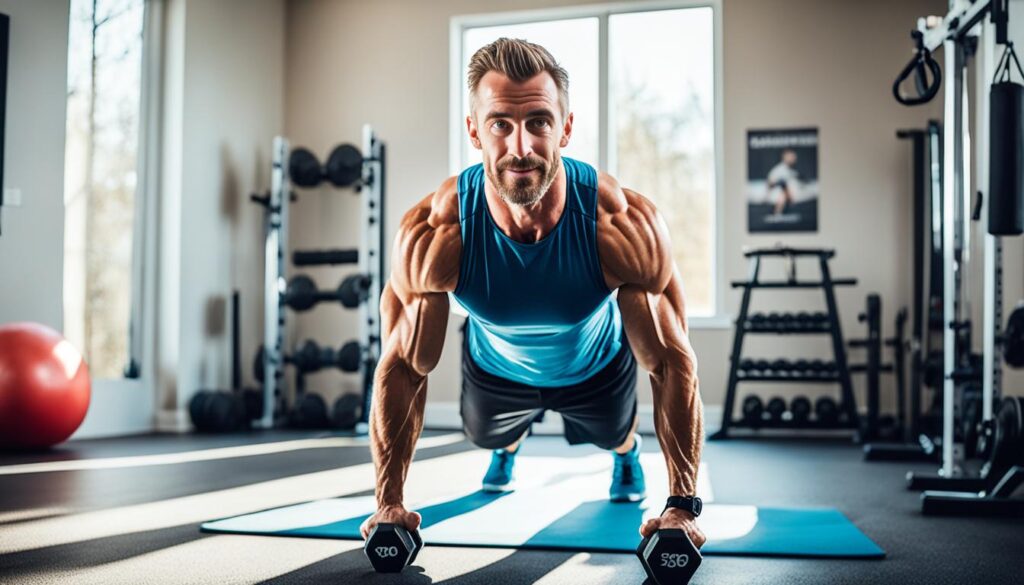
Remember, the key to success is consistency and adherence to your routine. Find a schedule that works for you and make a commitment to follow it regularly. By creating a workout plan that suits your goals, preferences, and available resources, you can establish a sustainable and effective at-home exercise routine.
Stay motivated and track your progress by keeping a workout journal or using smartphone apps that allow you to log your workouts and measure your progress over time. Celebrate your achievements, no matter how small, and don’t be afraid to challenge yourself with new exercises or increase the intensity of your workouts as you progress.
With a well-designed home workout routine and a positive mindset, you can achieve your fitness goals from the comfort of your own home.
Beginner Workout Routine
For beginners, starting with bodyweight exercises is a great way to build strength and endurance without the need for equipment. A beginner workout routine can include exercises such as bridges, chair squats, knee pushups, stationary lunges, planks, and more. These exercises can be performed in sets and repetitions, with rest periods in between. A beginner workout routine should focus on full-body exercises and gradually increase in intensity as the individual becomes more comfortable and proficient.
Here is a sample beginner workout routine that incorporates these bodyweight exercises:
| Exercise | Sets | Repetitions |
|---|---|---|
| Bridges | 3 | 10 |
| Chair Squats | 3 | 12 |
| Knee Pushups | 3 | 8 |
| Stationary Lunges | 3 | 10 (each leg) |
| Planks | 3 | 30 seconds |
This beginner workout routine targets multiple muscle groups in the body and can be performed 2-3 times a week, allowing for adequate rest and recovery. It provides a foundation of strength and prepares individuals for more advanced workouts in the future.
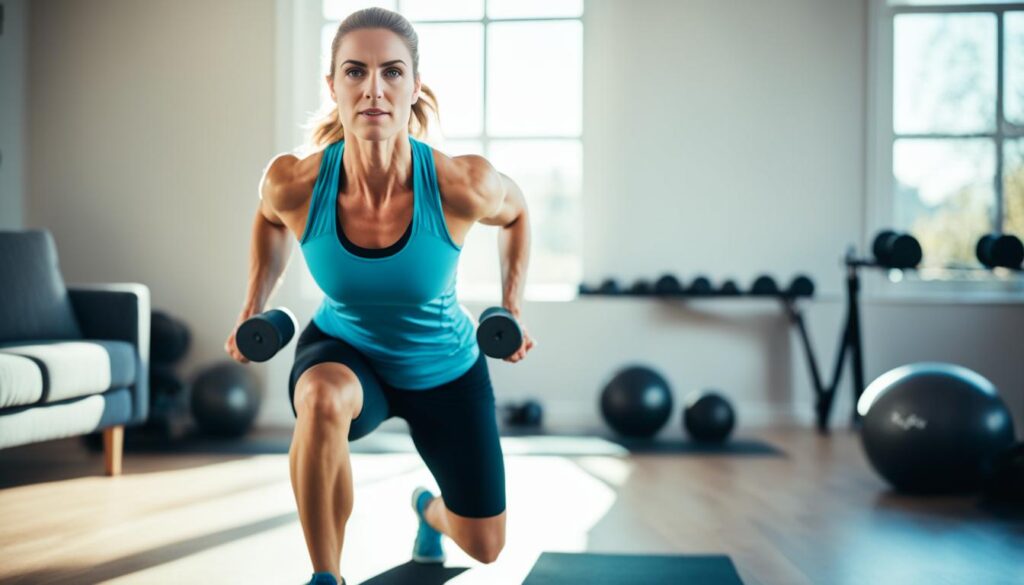
Remember to warm up before starting your workout, and cool down with some light stretching afterwards to prevent muscle soreness and promote flexibility. As you progress with your beginner workout routine, you can gradually increase the number of sets, repetitions, or try more challenging variations of the exercises to continue challenging your body and seeing improvements.
Intermediate Workout Routine
Once you’ve mastered the beginner routine, it’s time to level up and challenge yourself with an intermediate workout routine. This routine is designed to push your strength and endurance to new heights while allowing for progression and improvement.
The intermediate workout routine incorporates a variety of bodyweight exercises that target different muscle groups and promote overall fitness. By combining these exercises and following a well-structured routine, you can continue your fitness journey and achieve your goals in the comfort of your own home.
Intermediate Bodyweight Exercises
Here are some intermediate bodyweight exercises that you can include in your workout routine:
- Single-Leg Bridges: Strengthen your glutes, hamstrings, and lower back with this challenging variation of the bridge exercise.
- Squats: Engage your lower body muscles, including your quadriceps, hamstrings, and glutes, with this classic compound exercise.
- Pushups: Target your chest, triceps, and shoulders while also engaging your core muscles with proper form.
- Walking Lunges: Work on your lower body strength and stability by performing walking lunges, targeting your quadriceps, hamstrings, and glutes.
- Pike Pushups: Focus on your shoulders and upper body strength with this modified pushup exercise that places more emphasis on your shoulder muscles.
- Get-Up Squats: Combine a squat with a single-leg balance to challenge your lower body and core stability simultaneously.
These exercises can be performed in sets and repetitions, with the option to add timed rounds for a more advanced approach. Remember to maintain proper form throughout each exercise and gradually increase the intensity and volume as you progress.
“The key to an effective intermediate workout routine is finding the right balance between challenge and progression. By consistently challenging your body and gradually increasing the difficulty of your exercises, you can continue to see improvements and reach your fitness goals.” – Fitness Expert
Sample Intermediate Workout Routine
Here’s a sample intermediate workout routine that incorporates the mentioned exercises:
| Exercise | Sets x Repetitions |
|---|---|
| Single-Leg Bridges | 3 x 10-12 |
| Squats | 3 x 10-12 |
| Pushups | 3 x 8-10 |
| Walking Lunges | 3 x 10-12 (each leg) |
| Pike Pushups | 3 x 8-10 |
| Get-Up Squats | 3 x 10-12 |
Feel free to adjust the number of sets, repetitions, and rest periods based on your fitness level and capabilities. As you become more comfortable with the routine, consider adding additional rounds or increasing the difficulty of the exercises by exploring progressions or modifications.
Remember to prioritize proper form, listen to your body, and give yourself permission to rest and recover when needed. Pushing your limits is important, but so is taking care of yourself and preventing injury.
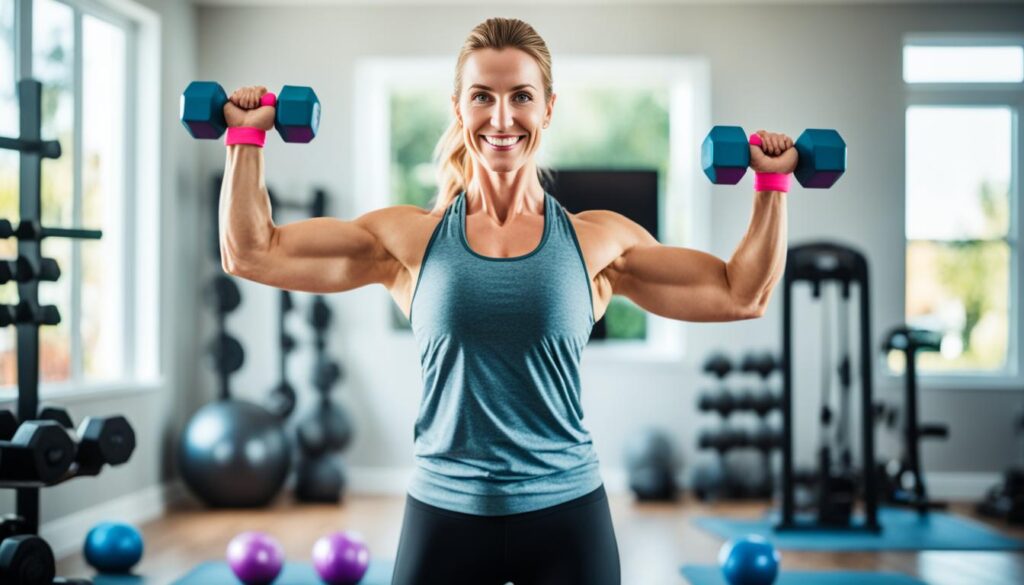
With dedication, consistency, and the right blend of exercises, an intermediate workout routine can help you continue to make progress and achieve your fitness goals right in the comfort of your home.
Advanced Workout Routine
For advanced trainees who have been consistently working out for a significant period, it’s time to challenge yourself with a more intense and diverse workout routine. By incorporating advanced bodyweight exercises and variations, you can stimulate new muscle growth, break through plateaus, and achieve greater progress.
Exercises to Include:
- Single-Leg Deadlifts: This exercise targets the hamstrings, glutes, and lower back while improving balance and stability. Stand on one leg and hinge forward at the hips, lowering the torso while extending the free leg behind you. Return to the starting position and repeat on the other leg.
- Hanging Leg Raises: Hanging from a pull-up bar, engage your core muscles and lift your legs up towards your chest while keeping them straight. Control the movement and lower your legs back down.
- Overhead Presses: Stand with a pair of dumbbells or a barbell at shoulder height. Press the weights overhead, fully extending your arms. Lower the weights back down with control.
- Barbell Squats and Deadlifts: These compound exercises target multiple muscle groups and build overall strength. Use proper form and gradually increase the weight as you progress.
- Bench Presses: Lie on a bench with a barbell, dumbbells, or resistance bands. Lower the weight to your chest, pause briefly, then press it back up to the starting position.
These advanced bodyweight exercises challenge your muscles in new ways and require a higher level of strength, coordination, and stability. Remember to listen to your body and maintain proper form throughout each exercise.
Advanced trainees should push their limits and incorporate variations to prevent plateaus and continue making progress in their fitness journey.
Increasing Intensity and Volume:
To continue challenging yourself as an advanced trainee, focus on gradually increasing the intensity and volume of your workouts. This can include:
- Increasing Resistance: Gradually increase the weight or resistance used in your exercises to continually challenge your muscles.
- Reducing Rest Times: Shorten the rest periods between sets to keep your heart rate elevated and maintain intensity throughout your workout.
- Adding Supersets or Circuits: Combine different exercises together, performing them back-to-back, to increase the overall intensity and efficiency of your workouts.
- Incorporating High-Intensity Interval Training (HIIT): Include bursts of intense exercises followed by short recovery periods to elevate your heart rate and improve cardiovascular fitness.
By continuously challenging yourself and progressively overloading your muscles, you can promote further strength gains and muscle growth.
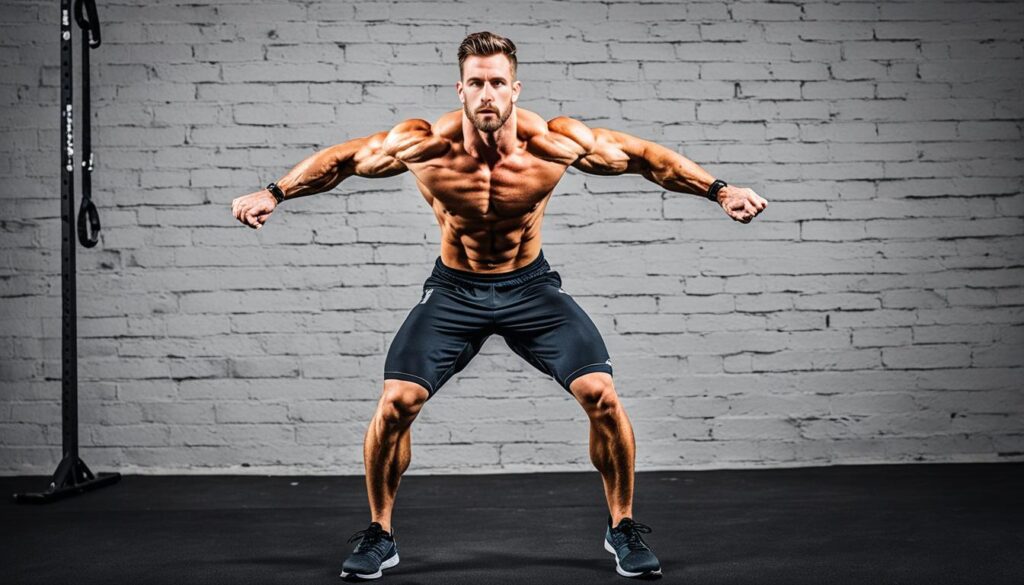
Achieving and maintaining a proper balance between intensity, recovery, and rest is crucial for advanced trainees to optimize their progress and minimize the risk of overtraining or injury.
Equipment for Home Workouts
While home workouts can be done with minimal or no equipment, having a few key pieces of equipment can enhance your workouts. Incorporating the right home workout equipment can add variety and intensity to your exercises, allowing for more effective and well-rounded workouts.
Essential Home Workout Equipment
Here are some essential pieces of workout equipment that you can consider including in your home gym:
- Dumbbells: Dumbbells are versatile and can be used for a wide range of exercises, such as bicep curls, shoulder presses, and lunges. They come in different weights, allowing you to adjust the intensity of your workouts.
- Resistance Bands: Resistance bands are lightweight and portable, making them a great option for home workouts. They provide resistance throughout the movement, helping to build strength and muscle endurance.
- Yoga Mat: A yoga mat provides cushioning and grip for floor exercises and stretching routines. It also helps to create a designated workout space and protect your floors.
- Running Sneakers: If running or jogging is part of your workout routine, investing in a good pair of running sneakers is important to provide support and cushioning for your feet.
- Punching Bag: For those who enjoy boxing or martial arts workouts, a punching bag can be a valuable addition to your home gym. It allows you to engage in high-intensity cardio and upper body workouts.
Additional Equipment and Accessories
In addition to the essential equipment mentioned above, there are a few other items that can enhance your home workout experience:
- Mirrors: Mirrors can be beneficial for checking your form and ensuring proper technique during exercises. They can also create an illusion of a larger space, making your home gym feel more open and motivating.
- Reflective Vest: If you prefer outdoor cardio workouts, such as running or cycling, wearing a reflective vest ensures visibility and safety, especially during low-light conditions.
Remember, the specific equipment you choose to include in your home gym should align with your fitness goals, preferences, and available space. It’s important to invest in high-quality equipment that is durable and suits your individual needs. By having the right equipment, you can optimize your home workouts and make progress towards your fitness goals.
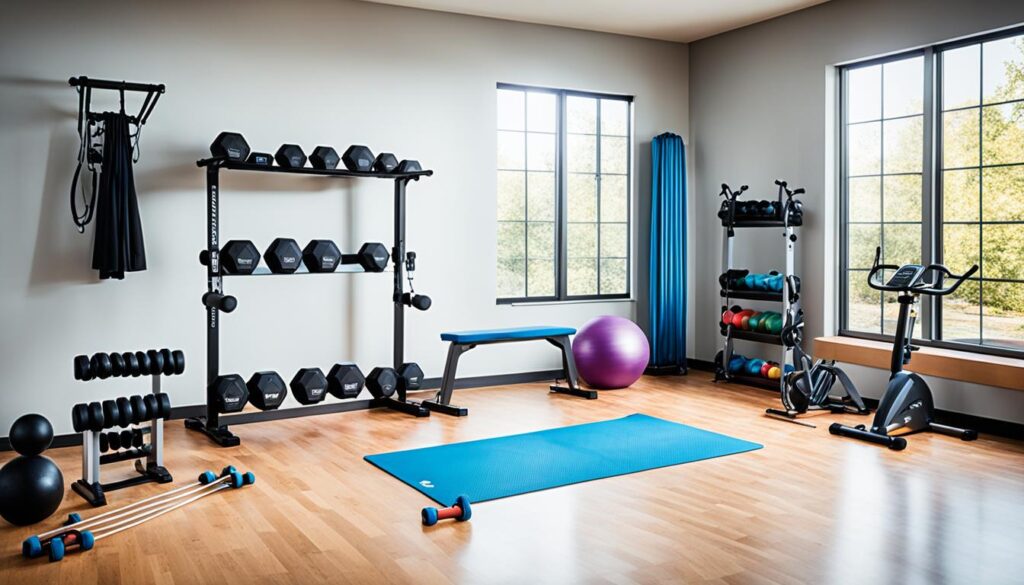
Setting Goals and Stay Motivated
Setting fitness goals is a crucial step in staying motivated and tracking progress in your home workouts. Whether you’re looking to lose weight, build muscle, increase endurance, or improve your overall fitness, having specific and achievable goals gives you something to work towards. Setting goals helps you maintain focus and provides a sense of accomplishment as you reach each milestone.
To effectively set goals for your home workouts, it’s important to follow a few guidelines:
- Be Specific: Clearly define what you want to achieve. Instead of saying “I want to get stronger,” set a specific goal like “I want to be able to do 10 push-ups without taking a rest.”
- Set Short-term and Long-term Goals: It’s essential to have a mix of short-term and long-term goals. Short-term goals can be achieved within a few weeks or months, while long-term goals may take several months or even a year.
- Break Down Goals: Breaking down your goals into smaller, actionable steps makes them more manageable and allows you to track progress along the way. For example, if your long-term goal is to run a marathon, your smaller steps might include running 5 kilometers, then 10 kilometers, and so on.
- Celebrate Milestones: Celebrate your achievements when you reach milestones. Rewarding yourself for your hard work and progress reinforces positive behavior and keeps you motivated.
- Adjust as Needed: As you progress in your fitness journey, it’s essential to reassess and adjust your goals as necessary. Your goals should evolve along with your fitness level and personal aspirations.
In addition to setting goals, finding ways to stay motivated is crucial for consistent workouts. Here are some tips to stay motivated in your home workouts:
- Find a Workout Partner: Working out with a partner can provide accountability and make your workouts more enjoyable. You can motivate each other, share progress, and push each other to reach new milestones.
- Follow an Online Workout Program: Joining an online workout program provides structure and guidance. It gives you a workout plan to follow and helps you stay committed and engaged.
- Reward Yourself: Set up a reward system for yourself. When you reach a specific goal or complete a challenging workout, treat yourself to something you enjoy, like a massage or a new piece of workout equipment.
- Track Your Progress: Keep a record of your workouts and track your progress. Seeing how far you’ve come can be highly motivating and remind you of the progress you’ve made.
- Find What You Enjoy: Experiment with different types of workouts and find activities you genuinely enjoy. When you enjoy what you’re doing, it’s easier to stay motivated and consistent in your workouts.
By setting goals and finding ways to stay motivated, you can maintain your dedication and commitment to your home workouts. Remember, fitness is a journey, and staying motivated is key to achieving long-term success.
Conclusion
In conclusion, home workouts offer a highly effective and convenient solution for achieving your fitness goals. Whether you’re a beginner, intermediate, or advanced trainee, there are countless workout routines and exercises that can be customized to fit your fitness level and preferences. By utilizing the right equipment, implementing goal-setting strategies, and staying motivated, you can create an enjoyable and effective workout routine that keeps you fit and healthy in the comfort of your own home.
Remember to always listen to your body and prioritize proper form to prevent injuries and maximize results. With the flexibility and accessibility of home workouts, you can easily incorporate fitness into your daily routine and avoid barriers such as travel time, expensive gym memberships, and self-consciousness.
So, get started on your gym workout at home today and experience the countless benefits of working out in your own space. Improve your strength, endurance, and overall fitness while enjoying the flexibility and convenience that home workouts provide. Make your fitness goals a reality by embracing the power of working out at home.










